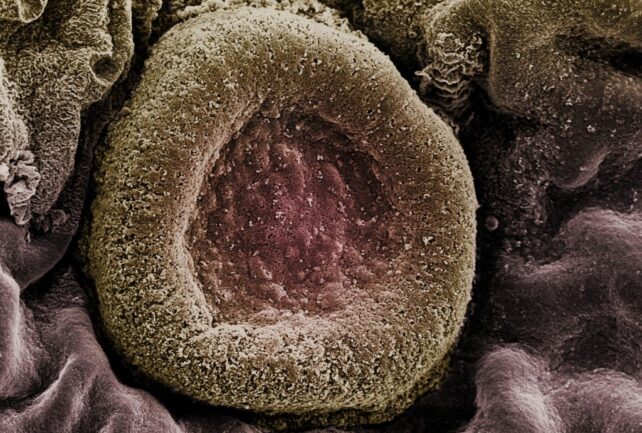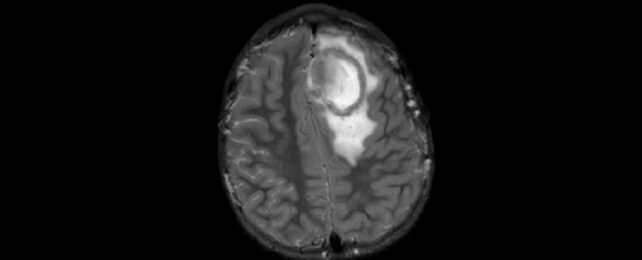Following the easing of pandemic restrictions in the US, cases of brain abscess in children under 18 have risen to new heights, according to a pair of CDC reports.
December 2022 saw a peak of 102 cases across the country. Since then, cases have fallen again but remained over the baseline maximum of 61 cases per month, up to and including March 2023.
These abscesses usually follow a respiratory infection – including COVID-19, the flu, or sinusitis – underscoring the importance that children remain up-to-date with their vaccinations, the CDC says.
Brain abscesses – even at these elevated numbers – are relatively rare, but they are also quite dangerous. They're an infection in your brain caused by bacteria or fungi that enter the brain, usually either via the bloodstream from an infection in another part of the body, like pneumonia, or through an infection in the head, such as the ears, teeth, or sinuses.
These pus-filled pockets can exert pressure on the brain tissue around it and even cut off blood flow. The abscesses can cause brain damage and, in severe cases, be fatal, so they need to be treated fairly quickly with antibiotics and, in some cases, surgery.
According to a report led by epidemiologist Emma Accorsi of the CDC, there were 34 cases a month of brain abscess as a baseline median from 2016 to 2019, based on hospitalization data. During this time, the baseline maximum was 61 cases in a month.
Then, the global COVID-19 pandemic hit the world in March 2020, and countries around the world began introducing measures to try to reduce the spread of infection, including wearing masks, using respirators to curtail aerosol transmission, and lockdowns, in which entire regions were confined to their homes to reduce person-to-person contact.

During the following months, many illnesses declined. Influenza cases, for example, dropped dramatically, as did respiratory syncytial virus (RSV) cases. It seems like cases of brain abscess caused by Streptococcus were another. This bacterium is commonly found in patients with RSV or influenza.
From May 2020, monthly cases dropped well below the baseline and remained that way until May 2021, the CDC reports. After this, however, cases started to climb to numbers significantly higher than those counted pre-pandemic.
"Although some variability between US Census Bureau regions was observed, overall patterns were generally similar: consistently low case counts after the onset of the pandemic, then a period of increase beginning in mid- to late-2021 followed by a large peak during winter 2022–2023," Accorsi and her team note.
Cases of brain abscess in children are recognized as a severe complication of viral respiratory infection in children. Following the easing of pandemic restrictions in 2022, respiratory viruses rose worldwide. In particular, cases of influenza and RSV surged to new heights, joining COVID-19 in a phenomenon that came to be known as the "tripledemic".
The cause of this, according to infectious disease expert Christopher Gill of Boston University, was a sort of rebound effect from the low infection rates during the height of pandemic restrictions.
"Due to the COVID-19 restrictions, in the past several years, we saw major declines in the incidence and impact of RSV and influenza. That was good, but also meant that the population was NOT acquiring as much herd immunity to those other viruses," he said in December 2022.
"At the same time, infants were still being born and adding to the population of susceptible individuals. The result was a bit like winding a clock spring too tightly, because now the rebound has been much more severe than in typical years. While this is a bit of a simplification of a very complex process, our best guess is that we are now in the midst of a planet-wide rebound of viral transmission."
After that record peak of 102 cases last December, more than triple the baseline median, cases of pediatric brain abscess began to fall. However, they remained above the baseline maximum of 61 monthly cases until March 2023. Data after this time was not included in the report.
Although the first report makes no speculations about the cause of the rise in cases, the second report, which specifically considers cases in Nevada, does make a tentative correlation. The researchers, led by Jessica Penney of the CDC, suggest that there might be a link between the rise in cases of brain abscess and the lifting of mask mandates in that state in February 2022.
Cases do remain rare, even at that peak number in December 2022, but the CDC will continue to monitor the phenomenon and suggest that doctors remain vigilant for the signs of brain abscess in children presenting with respiratory symptoms.
"CDC continues to track trends in pediatric intracranial infections," Accorsi and her team write, "and recommends that all persons aged ≤18 years remain current with recommended vaccinations, including influenza and COVID-19."
There's currently no RSV vaccine available for people under 60. But you can familiarize yourself with the symptoms of brain abscess on the Johns Hopkins Medicine website.
